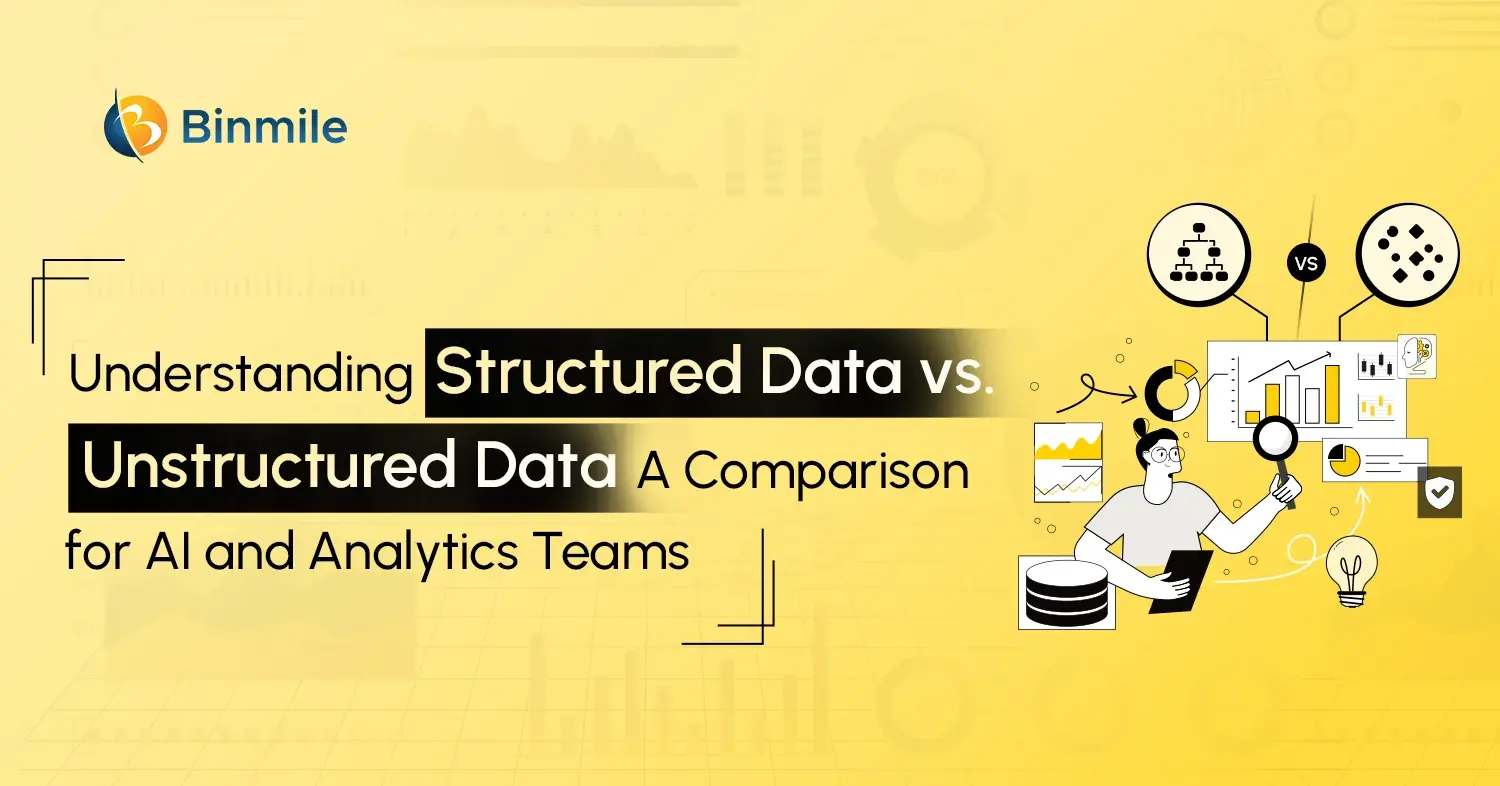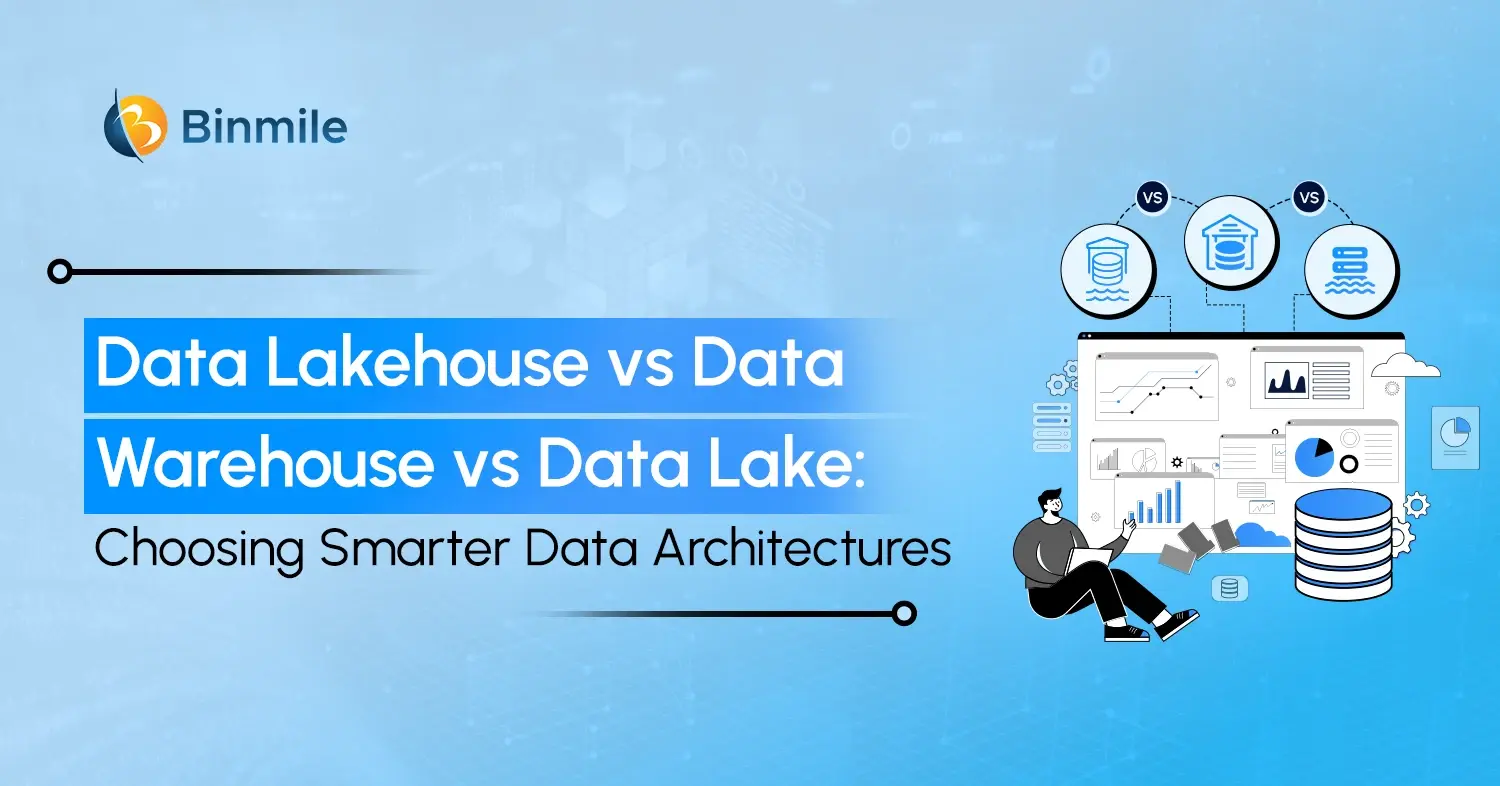- advantages of structured data
- advantages of unstructured data
- benefits of semi-structured data
- drawbacks of structured data
- drawbacks of unstructured data
- Structured and unstructured data
- Structured vs Unstructured Data
- use cases of structured data
- use cases of unstructured data
- what is structured data
- what is unstructured data
Data is the fuel that helps businesses drive growth, innovation, and competitive advantage in this digital-first business environment. Organizations often come across two types of data: structured vs. unstructured data. Structured data is quantitative data that you can organise and easily search like a table with rows and columns. Unstructured data does not follow a set format and can include various types of data, such as audio files, videos, or web pages. However, it is easier to misunderstand and misuse, resulting in everything from poor business decisions to consumers misunderstanding how their data is stored, secured, and used.
From customer insights and operational efficiency to forecasting trends and shaping strategies, knowing how these two data types function can determine how effectively you analyze, manage, and leverage information. So, what’s the difference? Which is better? In this blog, we will discuss what is the difference between structured data and unstructured data, their key differences, and how businesses can use each to gain actionable insights.
What is Structured Data?
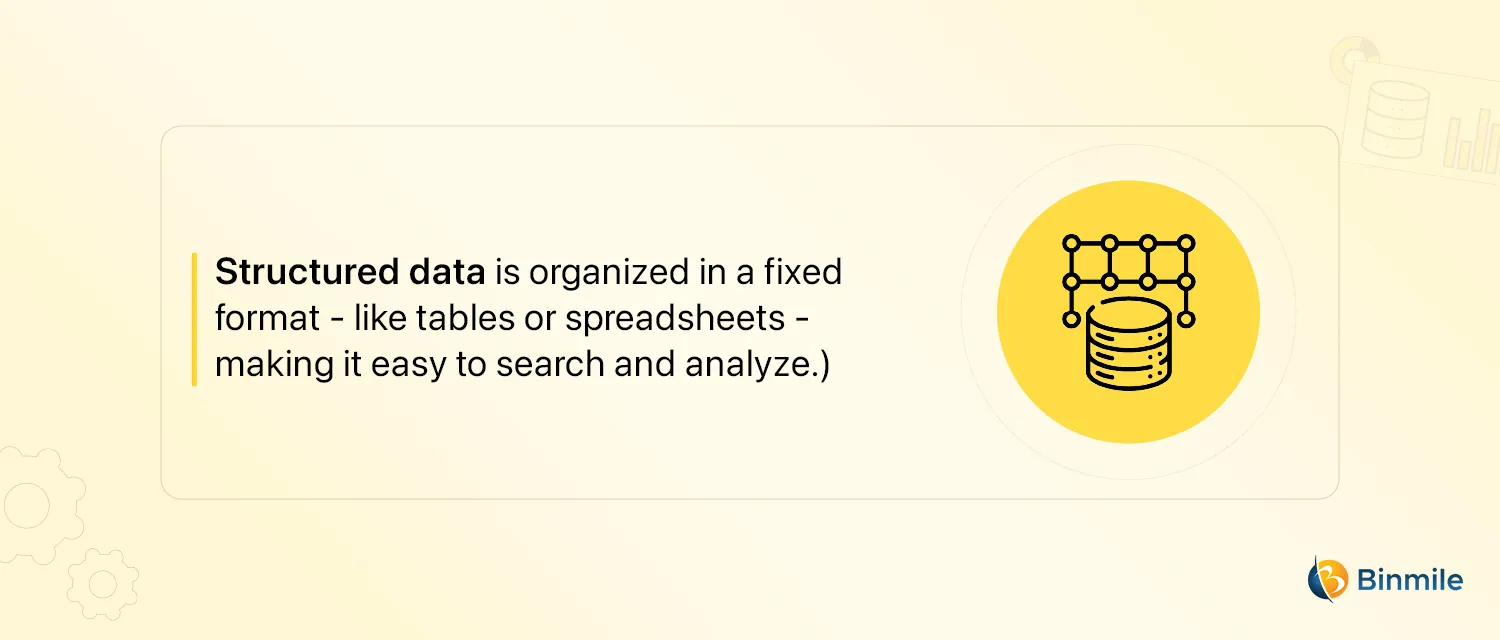
Structured data uses a predefined and expected format, and it can come from any source, but the fields are always fixed, and it is stored in a fixed manner (hence, structured). This predetermined data model enables easy entry, querying, and analysis.
Three types of structured data include: relational data (stored in tables with rows and columns, such as SQL databases), hierarchical data (follows a tree-like structure, where each data element has a parent and possibly multiple children, like XML documents), and tabular data (which is stored in spreadsheets or data tables, with rows representing records and columns representing attributes.)
For example: financial data, addresses, latitude and longitude, and dates.
How is Structured Data Used?
Structured data is usually stored in cells, rows, and columns, such as Excel spreadsheets and relational databases (or SQL databases). It lets users input, search, and manipulate structured data within an RDBMS by using languages like SQL.
Use cases for Structured Data include:
- Using Data Quality in AI & model training
- Customer relationship management (CRM)
- Inventory management in retail and logistics platforms.
- Healthcare records for diagnostics, billing, and regulatory compliance.
- Sensor data in IoT devices for real-time monitoring and automation.
Advantages of Structured Data
- Enables fast and precise data retrieval using SQL or similar tools.
- Enforces consistency through predefined schemas and validation rules.
- Seamlessly connects with BI interactive dashboards, tools, APIs, and relational databases.
- Optimized for large-scale storage in relational systems.
- Facilitates advanced reporting, trend analysis, and forecasting.
Limitations of Structured Data
- Difficult to adapt to evolving or unstructured data types, and needs to update all structured data, which is time and resource-intensive.
- Often lacks nuance or relationships beyond tabular formats.
- Requires upfront design, normalization, and ongoing maintenance.
What is Unstructured Data?
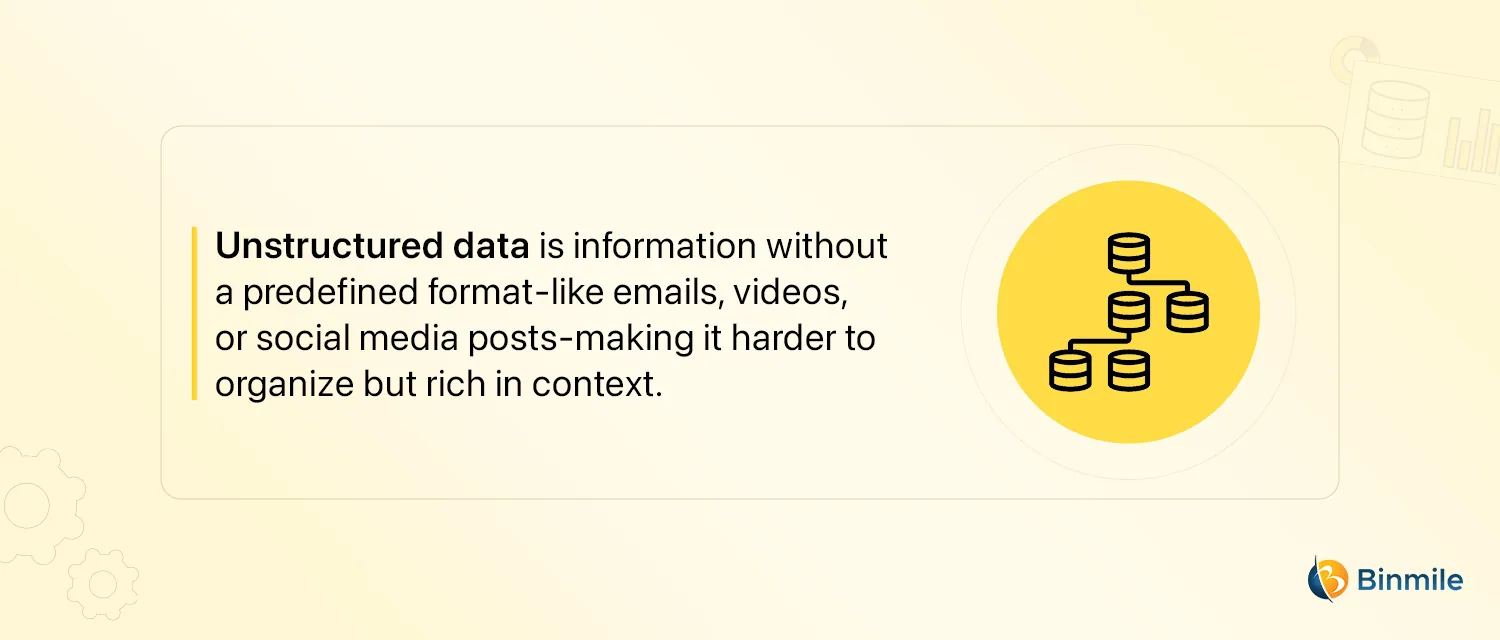
Unstructured data is data that cannot be analyzed or searched through traditional analytical methods. It has no pre-defined structure and is stored in its native format. Additionally, unstructured data can have both textual and nontextual data and both qualitative (social media comments) and quantitative (figures embedded in text) data.
For instance, email, social media posts, call transcripts, video, images, sensor data, and so on.
How is Unstructured Data Used?
Since unstructured data does not follow a predefined data model, it cannot be effectively processed or analyzed through data management tools and methods. Therefore, the best tool for handling this is non-relational or NoSQL databases or in data lakes. Other than that, ML models, advanced data analytics services, and natural language processing (NLP) are utilized to extract valuable insights from unstructured data.
Unstructured Data Use Cases Include:
- Generative AI (gen AI)
- Speech-to-Text Conversion
- Customer behavior and sentiment analysis
- Predictive data analytics
- Chatbot text analysis
Advantages of Unstructured Data
- Captures nuanced human expression from text, audio, and visuals.
- Supports diverse formats like emails, videos, and social posts.
- Enables dynamic analysis of live data streams and trends.
- Powers machine learning models for pattern and anomaly detection.
- Often easier to collect without rigid schema constraints.
Limitations of Unstructured Data
- Requires predefined structure, limiting flexibility.
- Since traditional tools are not adequate, specialized tools like MongoDB and Azure, among others, are used to manipulate the data.
- Demands ongoing schema updates and data normalization.
Structured vs Unstructured Data: What’s the Difference?
Structured and unstructured data serve very different purposes in analytics. One is built on fixed schemas and predictable formats, while the other thrives in flexibility and variety. Understanding these contrasts helps organizations choose the right approach for storage, processing, and insights. So, let us explore what the difference is between structured data and unstructured data:
1: Storage
- Structured data is usually stored in relational databases or data warehouses, where schemas and normalization keep everything consistent and queries fast. The trade-off is less adaptability when new data types appear.
- Unstructured data is often kept in NoSQL databases or data lakes in its raw form. It’s more flexible, but you need specialized tools to extract insights.
2: Use Cases
- Structured data drives machine learning models that rely on clean, tabular inputs, such as predictive analytics, dashboards, finance, supply chain, and CRM.
- Unstructured data powers NLP, computer vision, and generative AI, unlocking meaning from text, audio, and media. Most organizations use both together to get the full picture.
3: Complexity
- Structured data is easier to handle. SQL and standard reporting tools make it accessible to analysts and decision-makers.
- Unstructured data is trickier. Because it lacks consistency, it needs tagging, indexing, or AI-driven methods before it becomes useful, raising both the skill and processing requirements.
4: Scalability
- Structured data scales steadily but within limits. Relational systems can strain when data volume and diversity grow, since schemas must stay fixed.
- Unstructured data scales more freely. Modern data lakes can hold massive volumes of varied inputs without reformatting. The catch is that analyzing it at scale demands more advanced infrastructure.
When to Use Structured vs Unstructured Data: Best Applications
Both structured and unstructured data play distinct roles in driving business value, each with its own set of advantages and disadvantages. However, there are specific scenarios where one should be chosen over the others. We are discussing those below:
Use Structured Data When You Need:
- Accurate reporting and performance metrics
- Transactional analysis, like sales or revenue tracking
- Real-time dashboards and operational insights
- Compliance-friendly storage and audit readiness
Use Unstructured Data When You Need:
- Understanding customer sentiment and behavior
- Identifying trends from social, multimedia, or feedback data
- Enhancing personalization across products or services
- Uncovering patterns not visible in structured datasets
Bridging the Gap: Semi-Structured Data
Semi-structured data is emerging as one of the top data management trends and is the “bridge” between structured and unstructured data, and is very useful for web scraping and data integration. Even though data does not have a predefined data model, it uses metadata (for example, tags and semantic markers) to identify specific data characteristics and scale data into records and preset fields.
Key Examples of Semi-Structured Data Include:
- JSON files: used in APIs and modern web applications
- XML data: common in data exchange between systems
- NoSQL databases: flexible storage for mixed data formats
- Email metadata: timestamps, sender info, and subject lines
- Sensor-generated logs: IoT devices capturing labeled but variable data
Why Semi-Structured Data is Crucial for Modern Businesses
With advanced analytics and AI-powered tools, semi-structured data has become crucial for modern data strategies, helping organizations bridge the gap between structured and unstructured information.
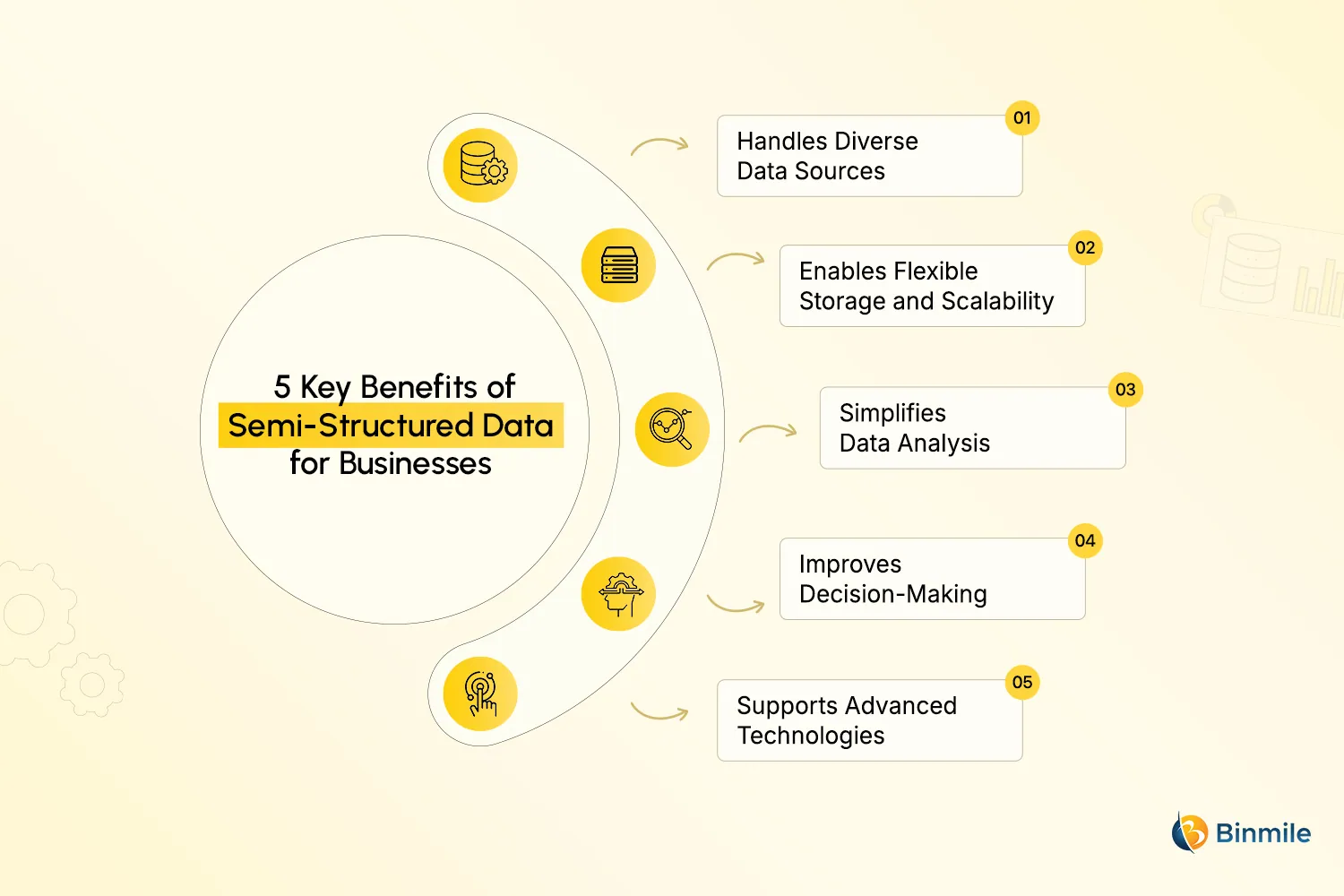
1. Handles Diverse Data Sources
Due to its capabilities to extract data from multiple channels such as web analytics, IoT sensors, emails, social media, and CRMs, without forcing everything into a rigid schema. Semi-structured data makes integration smoother and more efficient in a database management system.
2. Enables Flexible Storage and Scalability
Unlike structured data, semi-structured formats are adaptable to ever-evolving business needs. As NoSQL databases and data lakes are able to store large volumes of mixed data types without redesigning database structures, this ensures scalability as data grows.
3. Simplifies Data Analysis
With tags, labels, and key-value pairs, semi-structured data is easier to search, organize, and analyze compared to fully unstructured data. Businesses, therefore, can extract meaningful insights faster using modern analytics and AI-driven tools.
4. Improves Decision-Making
By combining the elements of both structured and unstructured data, semi-structured data offers a more complete view of business operations and customer behavior, enabling smarter, data-driven decisions that directly impact performance, efficiency, and customer experience.
5. Supports Advanced Technologies
Data is partially organized in a format that makes it easier for data engineering for AI, machine learning, and predictive analytics tools to work seamlessly and efficiently. It also allows these technologies to process complex information efficiently, helping businesses innovate, personalize customer experiences, and stay competitive.
Wrapping Up the Structured vs. Unstructured Data Difference
Data has transformed the way businesses approach analytics and decision-making. With growing volumes of information generated every second, organizations need the ability to collect, process, and analyze data effectively to stay competitive. Structured data offers speed, accuracy, and scalability, making it easier to track trends and manage operations efficiently. Unstructured data, on the other hand, provides deeper insights and context, unlocking patterns that structured formats alone cannot reveal. So, in the debate of structured vs unstructured data, the best solution is the hybrid approach through semi-structured data.
Hopefully, this blog has given you a clear understanding of structured vs unstructured data and how they differ in storage, format, and analysis. Despite their differences, both data types are critical to driving innovation and improving business outcomes. Companies that learn to integrate and leverage data engineering consulting services can extract actionable insights, optimize performance, and make smarter, data-driven decisions with confidence.
Want to explore how to make better use of your business data? Contact us for a free Data strategy consultation and explore tailored analytics solutions for your organization.
